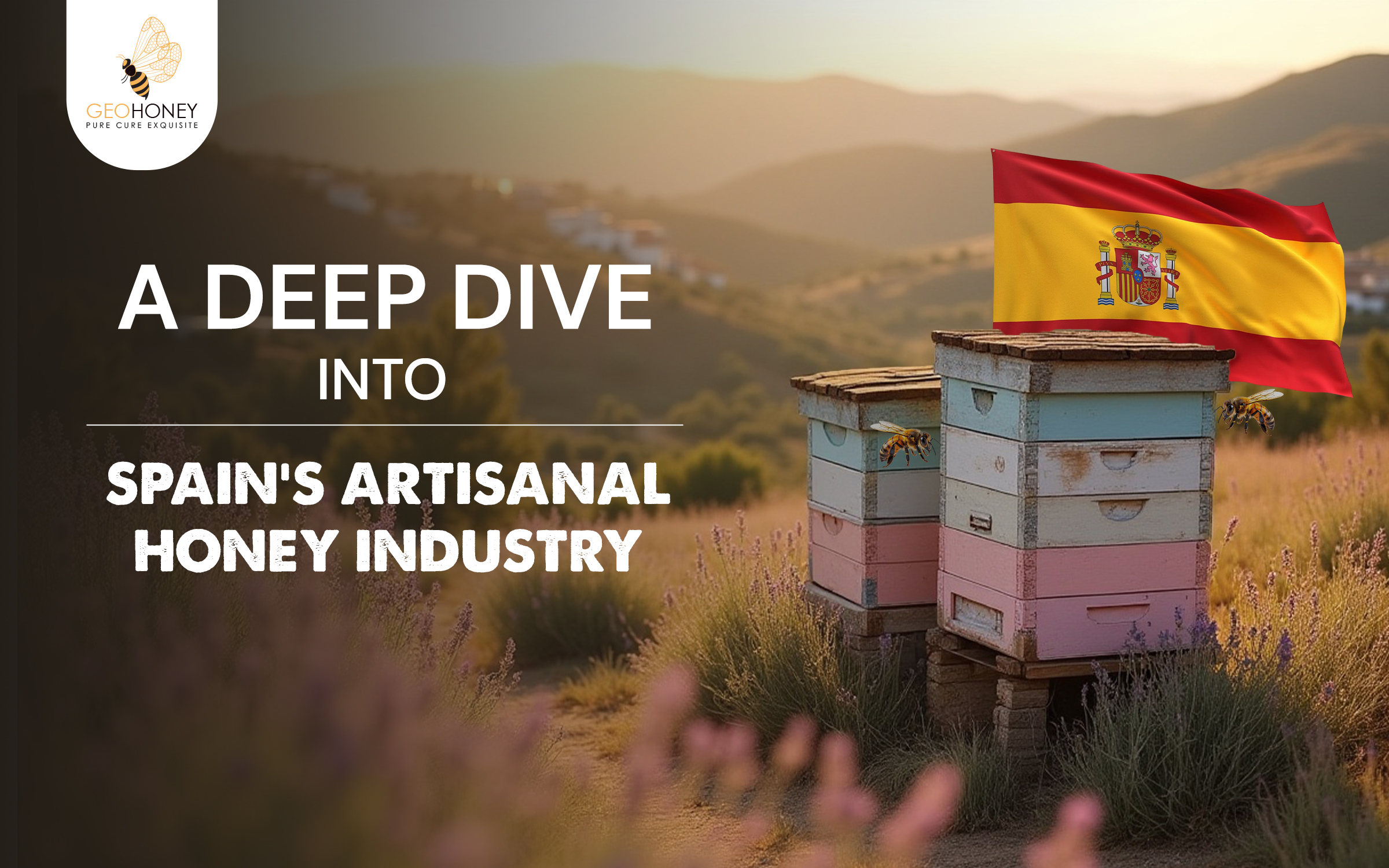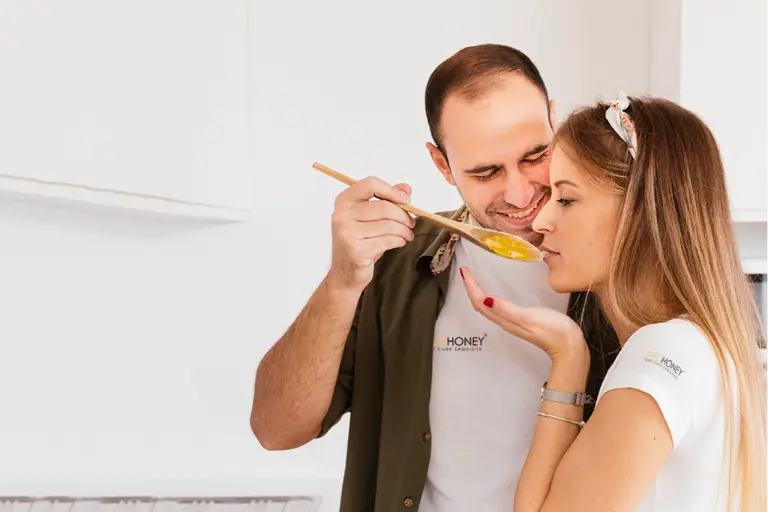- Tokyo: 23:11
- Singapore: 22:11
- Dubai: 18:11
- London: 14:11
- New York: 09:11
A Deep Dive into Spain’s Artisanal Honey Industry

Spanish artisanal honey is a gourmet food ingredient that also possesses exceptional medicinal and healing properties. This golden elixir has a centuries-old legacy that spans across the vast, unspoiled landscapes of Northern Spain.
From the mountainous Galicia regions to the thyme-covered Andalusian hills, Spain has to offer a variety of honey types, each capturing the essence of the region’s age-old tradition and beekeeping excellence.
“Spanish artisanal honey stands out for its purity, exclusivity, and deep cultural roots.”, says the founder of Geohoney and the CEO of B A Barry Group, Mr Basem Barry.
This honey is not made in commercial apiaries. Instead, it is the result of the combined efforts of bees and the hardworking local beekeepers who make sure to prepare the purest honey you can ever find.
This blog explores Spain’s artisanal honey industry in detail, highlighting why it is becoming the top choice for both domestic and commercial consumers. So, keep on reading till the end.
A Quick Look into Spain’s Artisanal Honey Market
What Makes Spanish Artisanal Honey Special?
Deep Historical and Cultural Roots
Geographical and Botanical Diversity
Production Scale and Structure
Artisanal Beekeeping Practices to Ensure the Best Quality
A Quick Look into Spain’s Artisanal Honey Market
Spain’s local beekeeping sector produces about ~€60‑70 million worth of honey and honey-related products like beeswax, propolis, royal jelly and bee pollen annually. This country is the second largest honey producer in Europe, with a staggering 31,000 tons of annual output.
The artisanal honey produced in this region comes with a much higher price tag owing to the intricate craftsmanship and the limited production.
Spain consumes about 0.6-0.7 kg of honey per person, and most of it is produced locally. The honey market in this region is expected to grow even further, owing to the fully organic processing and unique floral origin of the products that it offers.
What Makes Spanish Artisanal Honey Special?
There are a number of reasons why Spain’s artisanal raw honey industry has been able not only to stand the test of time but also grow at an incredible rate. The following are just a few points that show what makes the honey prepared in this region so special.
Deep Historical and Cultural Roots
Honey production and beekeeping in Spain have deep and carefully preserved roots that date back to Roman times. Mainly, the native Apis mellifera Iberica or the Spanish bee is responsible for most of the pollination and honey production in this area.
Beekeepers in Spain still use the traditional methods that have been passed down through generations to grow their hives and harvest honey. These artisans have a deep understanding of the regional flora, harvesting times, and hive placement, which ensures every spoonful of honey they harvest is nothing but pure.
Most of the honey production in the region is done by family-based beekeepers who use ancient tools and methods to ensure the honey is always raw and minimally processed. Unlike commercially produced honey, the Spanish artisanal honey is rich in natural enzymes, antioxidants, and vitamins that impart a great flavor as well as countless health benefits to it.
Geographical and Botanical Diversity
Spanish artisanal honey has no match due to the floral and geographical diversity of the region. The are diverse zones including islands (the Balearic and Canary), mountains, Mediterranean, and subtropical regions that produce several types of flora, including wild herbs, heather, chestnut, and eucalyptus, to name a few.
Spain has introduced PDOs (Protected Designation of Origin) and PGIs (Protected Geographical Indications) labels to ensure the authenticity and regional identity of its artisanal honey.
Some notable regions include:
Miel de Galicia (PGI), which is known for its mild climate and diverse honey varieties like chestnut, heather, blackberry, eucalyptus, etc.
Miel de Ibiza (PDO), which produces thyme honey, yellow clover honey, and rockrose honey.
Miel de La Alcarria (PDO), which is known for its floral nectar honeys like rosemary, lavender, and thyme.
Miel de Villuercas‑Ibores (PDO), which produces broom honey, mountain chestnut honey, and forest honey varieties.
Production Scale and Structure
The production scale and structure in the region focus on sustainability and minimal intervention to help preserve natural bee behavior.
Spain holds a big share of hives in all of Europe. The natural monofloral and wildflower honey production in Spain is no more than 30,000-35,000 tons in a year.
Regions like Valencia, Andalusia, and Castilla y León produce more than 70% of the region’s honey. There are very few commercial beekeepers in the region who manage over 150 hives. Most of the production is done by smaller artisans who focus more on quality, purity, and traceability rather than profitability.
Artisanal Beekeeping Practices to Ensure the Best Quality
Here are some key traditional artisanal beekeeping practices that are used in Spain to produce pure organic honey.
Family-Owned Businesses and Minimal Processing
Spain’s artisanal honey is unique for a number of reasons. First and foremost, this honey is produced under the supervision of family beekeepers who give special attention to its quality, craftsmanship, and local identity.
These beekeepers emphasize the utilization of single floral sources or specific plants or habitats to prepare monofloral artisanal honey with a unique flavor profile.
Unlike regular honey, Spanish artisanal honey doesn’t undergo aggressive filtration or heavy heating, which preserves most of its flavor, aroma, pollen content, and nutritional profile. This honey is cold-harvested, unpasteurized, and unfiltered, which allows it to retain its natural nutrients and enzymes.
Moreover, under Spain’s PGI and PDO rules, beekeepers have to work with registered hives and pay attention to marking, labelling, and pollen testing to further maintain the highest quality and authenticity.
Nomadic Beekeeping
A common practice among Spanish beekeeping that is still used today is the "trashumancia apícola," which means to migrate bee colonies based on the seasons from lowland to highland pastures and vice versa. This practice leads to healthier bee colonies and rich honey flavors that result from diverse nectar sources and the availability of plenty of nectar.
Minimal Intervention
Traditional Spanish beekeepers use minimally invasive methods to raise bee colonies. They allow bees to build their own combs, use organic and chemical-free pest treatment methods, and allow the bees to follow natural reproduction cycles instead of artificially replacing queens.
This gives you artisanal honey that is truly terroir-driven and has a flavor that captures the very specific essence of the local environment.
Eco-friendly Beekeeping
Traditional Spanish beekeepers use fully organic or near organic practices such as minimal or no pesticide use, planting and nurturing local flora, and using less harmful honey harvesting methods like smoke from a local herb like rosemary or thyme. These practices not only preserve bees but also ensure the honey is as pure as can be.
Traditional Spanish Beehives
Traditional Spanish beekeepers from Extremadura and Andalusia use trunk hives called “colmenas de corcho” or “troncos colmeneros.”, which are made from hollowed out cork oak logs or tree trunks capped at both ends. These hives are placed horizontally, and they are surrounded by stonewalls or clay to protect bees from predators and heat.
Other traditional regional hive variations are clay hives and Wicker skeps, which are designed to give bees a safe, cozy, and nourishing environment where they can grow and prepare the purest artisanal Spanish honey, which we all know and love today.
Conclusion
Traditional Spanish beekeeping is not about honey harvesting alone. It is a way of life that is rooted deep in nature, tradition, and local craftsmanship. Every jar of Spanish artisanal honey carries with it the region’s cultural and geographical essence.
The Spanish artisanal honey industry has a very bright future ahead as the consumer demand for traceable, authentic, and terroir-specific honey rises.
The convergence of rich landscapes, diverse flora, and skilled craftsmanship makes Spain’s artisanal honey a true natural treasure that is special not only in terms of its flavor but also in terms of its health and nutritional benefits.
Visit us at Geohoney today to explore our wide range of pure, raw, artisanal honey varieties to get the best flavor, nutrition, and health benefits all in one.


